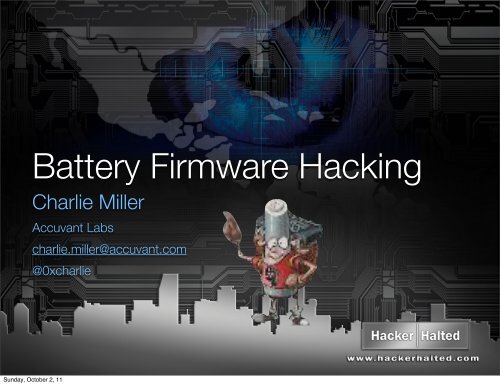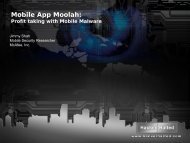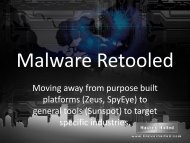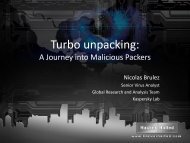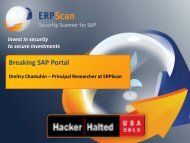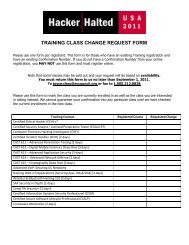Battery Firmware Hacking - Hacker Halted
Battery Firmware Hacking - Hacker Halted
Battery Firmware Hacking - Hacker Halted
You also want an ePaper? Increase the reach of your titles
YUMPU automatically turns print PDFs into web optimized ePapers that Google loves.
<strong>Battery</strong> <strong>Firmware</strong> <strong>Hacking</strong><br />
Charlie Miller<br />
Accuvant Labs<br />
charlie.miller@accuvant.com<br />
@0xcharlie<br />
Sunday, October 2, 11
About me<br />
Former US National Security Agency researcher<br />
First to hack the iPhone and G1 Android phone<br />
Winner of CanSecWest Pwn2Own: 2008, 2009, 2010, 2011<br />
Author<br />
Fuzzing for Software Security Testing and Quality<br />
Assurance<br />
The Mac <strong>Hacker</strong>’s Handbook<br />
PhD, CISSP, GCFA, etc.<br />
Sunday, October 2, 11
About me<br />
Former US National Security Agency researcher<br />
First to hack the iPhone and G1 Android phone<br />
Winner of CanSecWest Pwn2Own: 2008, 2009, 2010, 2011<br />
Author<br />
Fuzzing for Software Security Testing and Quality<br />
Assurance<br />
The Mac <strong>Hacker</strong>’s Handbook<br />
PhD, CISSP, GCFA, etc.<br />
Sunday, October 2, 11
Something different<br />
http://www.youtube.com/watch?v=jjAtBiTSsKY<br />
Sunday, October 2, 11
Spoiler<br />
I didn’t blow up batteries<br />
Didn’t do too much twiddling of parameters in my<br />
house<br />
Would like to continue to take my laptop on airplanes<br />
Might be able to take this work and do it<br />
Sunday, October 2, 11
Agenda<br />
Basics on smart batteries systems<br />
A journey into a MacBook’s battery’s (lack of) security<br />
mechanisms<br />
Potential impact<br />
Sunday, October 2, 11
Smart battery<br />
“Safety is a primary design goal in the Smart <strong>Battery</strong> System<br />
specifications. The central concept behind the Smart <strong>Battery</strong><br />
specifications is locating the primary intelligence of the system<br />
inside the battery pack itself. This enables the system to be<br />
much more accurate in measurement of battery parameters such<br />
as remaining capacity and design voltage, and also allows the<br />
charging algorithm and parameters to be tuned to the battery<br />
pack’s specific chemistry. By relying on the battery pack’s<br />
intelligence, a properly designed Smart <strong>Battery</strong> system will safely<br />
charge and discharge any expected battery chemistry.”<br />
- Smart <strong>Battery</strong> System Specifications document<br />
Sunday, October 2, 11
Smart batteries<br />
Have an embedded controller which communicate with<br />
the charger and host<br />
Has a responsibility to maintain safety<br />
Can be configured for different parameters/chemistries<br />
Sunday, October 2, 11
Possible <strong>Battery</strong> Attacks<br />
Brick battery on victim<br />
Reprogram to remove safety features and allow<br />
explosion (thermal runaway)???<br />
Persistent DOS to OS<br />
Persistent backdoor to OS (requires kernel bug)<br />
TPM, BIOS sniffer<br />
Sunday, October 2, 11
How to start<br />
I suck at hardware, so look for associated software<br />
Sunday, October 2, 11
How to start<br />
I suck at hardware, so look for associated software<br />
Sunday, October 2, 11
<strong>Battery</strong> updater<br />
Lots of calls to a function<br />
that basically wraps<br />
IOConnectMethodStructure<br />
IsStructure<br />
This is a function which<br />
passes data to a driver<br />
The driver in this case is<br />
AppleSmart<strong>Battery</strong>Manager<br />
Sunday, October 2, 11
AppleSmart<strong>Battery</strong><br />
Is part of PowerManagement package<br />
source code available, but won’t compile<br />
missing many things, but lots of nice info in headers<br />
Sunday, October 2, 11
More battery updater<br />
It does things like read the device name and compare<br />
to a list of devices to update or not (DeviceNameCmd)<br />
Read and check firmware version and pack lot code<br />
(ManufactureDataCmd)<br />
And some other ones that aren’t defined in the header<br />
file<br />
Sunday, October 2, 11
One odd thing<br />
What’s up with 0x3672 and 0x0414?<br />
Sunday, October 2, 11
Google!<br />
Sunday, October 2, 11
Double win!<br />
We now know its some kind of Texas Instruments chip<br />
We also know Apple used the default Unseal key<br />
We can verify that Apple also used the default Full-<br />
Access key<br />
Thanks!<br />
Sunday, October 2, 11
Double win!<br />
We now know its some kind of Texas Instruments chip<br />
We also know Apple used the default Unseal key<br />
We can verify that Apple also used the default Full-<br />
Access key<br />
Thanks!<br />
Sunday, October 2, 11
Double win!<br />
We now know its some kind of Texas Instruments chip<br />
We also know Apple used the default Unseal key<br />
We can verify that Apple also used the default Full-<br />
Access key<br />
Thanks!<br />
Sunday, October 2, 11
Which chip?<br />
Its a long story...<br />
Each chip returns slightly different data flash lengths<br />
for each “subclass”<br />
I wrote a script to get these values and then manually<br />
looked for this “fingerprint” in all the TI design docs<br />
Eventually found one that matched<br />
Note: I really don’t like to mess with hardware!<br />
Sunday, October 2, 11
Data flash signature<br />
SubclassID:bytes returned<br />
0: 22<br />
1: 25<br />
2: 10<br />
3: 1<br />
...<br />
Sunday, October 2, 11
Data flash signature<br />
SubclassID:bytes returned<br />
0: 22<br />
1: 25<br />
2: 10<br />
3: 1<br />
...<br />
Sunday, October 2, 11
Data flash signature<br />
SubclassID:bytes returned<br />
0: 22<br />
1: 25<br />
2: 10<br />
3: 1<br />
...<br />
Sunday, October 2, 11
Data flash signature<br />
SubclassID:bytes returned<br />
0: 22<br />
1: 25<br />
2: 10<br />
3: 1<br />
...<br />
Sunday, October 2, 11
Data flash signature<br />
SubclassID:bytes returned<br />
0: 22<br />
1: 25<br />
2: 10<br />
3: 1<br />
...<br />
Behaves like a TI bq20z80<br />
Sunday, October 2, 11
The right way to do it<br />
Sunday, October 2, 11
Step 2<br />
Sunday, October 2, 11
Step 3<br />
Lithium Polymer cells<br />
Electronics<br />
Sunday, October 2, 11
Step 4<br />
Chips<br />
and stuff<br />
Sunday, October 2, 11
Step 5<br />
TI bq29312<br />
Sunday, October 2, 11
Thx:<br />
Travis<br />
Goodspeed<br />
Sunday, October 2, 11
Step 6<br />
TI bq29412<br />
TI bq20z80<br />
Sunday, October 2, 11
Sunday, October 2, 11
Another clue I missed<br />
From AppleSmart<strong>Battery</strong>Commands.h<br />
Sigh, I suck<br />
Sunday, October 2, 11
Digression<br />
We now know what kind of hardware is on the battery<br />
We can get data sheets for it<br />
We can see how to talk to the driver which talks to the<br />
battery<br />
What kinds of things can we say to it and how does it<br />
work?<br />
Sunday, October 2, 11
Smart <strong>Battery</strong> System (SBS)<br />
Sunday, October 2, 11
Using the API<br />
Sunday, October 2, 11
SLUU276<br />
Document outlines all<br />
SBS commands<br />
Documents DataFlash<br />
For bq20z80-V100 +<br />
bq29312A chipset<br />
That’s us!<br />
Sunday, October 2, 11
Lots to do!<br />
There are many<br />
interesting writable<br />
configuration values<br />
Design capacity<br />
FET control<br />
Design voltage<br />
Device chemistry<br />
Cell overvolt threshold<br />
Pack overvolt threshold<br />
Overcharge threshold<br />
Overtemp threshold<br />
2nd level voltage<br />
threshold<br />
2nd level charge<br />
threshold<br />
2nd level temp theshold<br />
Impedance table<br />
Temp model<br />
Sunday, October 2, 11
Twiddle-twiddle<br />
unseal<br />
I played with these values but<br />
nothing too interesting happened<br />
It still stopped charging when it<br />
was really supposed to do so<br />
Needed to dig deeper<br />
full access<br />
Boot ROM<br />
Sunday, October 2, 11
Different modes<br />
Sealed<br />
Unsealed<br />
Full Access<br />
Configuration<br />
BootROM<br />
Sunday, October 2, 11
Sealed<br />
From the factory<br />
Only standard (not extended) SBS commands available<br />
Standard commands only have read access<br />
Sunday, October 2, 11
Unsealed<br />
Access to Data Flash space<br />
Access to some extended SBS commands<br />
Some SBS commands have read/write access<br />
Apple battery firmware updates enter this mode<br />
Sunday, October 2, 11
Full access mode<br />
All SBS commands<br />
All commands have read/write access<br />
Can enter BootROM and Configuration mode<br />
Apple firmware updates do not enter this mode<br />
Sunday, October 2, 11
Configuration mode<br />
By issuing SMBus commands (see slua355b) you tell<br />
the battery what levels of current, voltage, temp it is<br />
currently receiving<br />
It then makes internal changes to align itself with these<br />
values<br />
write_word(0, 0x40); //enter calibrate mode from full access mode<br />
write_word(0x63, n); //n = number of cells<br />
write_word(0x60, n); //n = current<br />
write_word(0x61, n); //n = voltage<br />
write_word(0x62, n); //n = temp<br />
write_word(0x51, 0xc0d5); //calibrate device.<br />
read_word(0x52, y); //y = bit field, whats calibrated. (poll with this)<br />
send_byte(0x72);<br />
send_byte(0x73);<br />
//transfer results to data flash<br />
//exit Calibration mode.<br />
Sunday, October 2, 11
Other calibrations?<br />
Sunday, October 2, 11
Other calibrations?<br />
Sunday, October 2, 11
Other calibrations?<br />
Sunday, October 2, 11
Other calibrations?<br />
Yes, I’m a prodigy<br />
Sunday, October 2, 11
Boot ROM mode<br />
Allows low level access to device, direct access to data<br />
flash and firmware<br />
bq20z80-V110 + bq29312A Chipset Technical<br />
Reference Manual does not document it<br />
Time to buy some hardware, sigh<br />
Sunday, October 2, 11
q20z80evm-001<br />
An evaluation system for the bq20z80/bq2312a/<br />
bq29400 smart battery chipset<br />
Almost exactly the chipset on the Apple Macbook<br />
battery<br />
Comes with Windows software to interact with it via<br />
USB<br />
Sunday, October 2, 11
My test rig<br />
Sunday, October 2, 11
The software<br />
Sunday, October 2, 11
Read/write SBS<br />
Sunday, October 2, 11
Data flash<br />
Sunday, October 2, 11
Pro<br />
<strong>Firmware</strong> flash<br />
Hell yea<br />
Raw SMBus commands<br />
Sunday, October 2, 11
EVM<br />
It can flash the firmware with a “srec” file which comes<br />
with the kit<br />
Need to sniff what it’s doing so we can figure out<br />
bootROM mode and copy it<br />
Sunday, October 2, 11
senc files<br />
“encrypted” SREC file<br />
Where encryption = fancy xor magic<br />
SREC files contain<br />
Some header stuff<br />
Full data flash<br />
Instruction flash<br />
Checksums<br />
Sunday, October 2, 11
Introspection<br />
Wrote a PyDbg script<br />
which intercepted data<br />
before going over USB<br />
Could compare this data<br />
to the raw read/writes on<br />
Pro screen<br />
Interpret data during<br />
reprogramming<br />
Sunday, October 2, 11
Some analysis<br />
SMBus command<br />
Read word: 0x8<br />
Write word: 0x4<br />
Read block: 0x2<br />
Write block: 0x5<br />
Sunday, October 2, 11
Google again<br />
Googling these types of commands, numbers revealed<br />
the bq803xx ROM API v3.0 User’s Guide<br />
This documents the layout of the firmware as well as all<br />
the Boot ROM routines<br />
Sunday, October 2, 11
EVM Programming SENC<br />
<br />
<br />
(0200)<br />
(0201)<br />
...<br />
(023e)<br />
// program flash data<br />
(00)<br />
(01)<br />
...<br />
(1a)<br />
(30)<br />
(31)<br />
...<br />
(37)<br />
<br />
// program flash code<br />
(0002)<br />
(0002)<br />
<br />
(0003)<br />
(0003)<br />
<br />
...<br />
(02ff)<br />
(02ff)<br />
<br />
(0000)<br />
(0000)<br />
<br />
(0001)<br />
(0001)<br />
<br />
Erase everything<br />
Program 0x38 rows of flash data<br />
Program 0x300 rows<br />
of instruction flash<br />
Sunday, October 2, 11
Boot ROM - mostly ok<br />
See how to write to Boot ROM - except what’s up with the<br />
checksums and stuff...<br />
Can probably figure out how to read from Boot ROM from the<br />
doc, although no live examples<br />
Can also probably get all data flash, not just the SBS<br />
accessible stuff<br />
Can see what the instruction flash looks like by recording the<br />
SMBus writes during EVM reprogramming<br />
Need to know what kind of machine code is in there!<br />
Sunday, October 2, 11
Instruction Flash Contents<br />
We’d like to disassemble the firmware<br />
Need to know what kind of chip it is for<br />
Tried all the ones in IDA Pro, none disassemble well<br />
Sunday, October 2, 11
Let’s ask TI!<br />
Sunday, October 2, 11
Thanks...<br />
Sunday, October 2, 11
Plz!<br />
Sunday, October 2, 11
Go away, kid<br />
Sunday, October 2, 11
Intellectual property - Here I come!<br />
Mostly binary stuff<br />
What’s with the 3’s?<br />
Sunday, October 2, 11
Intellectual property - Here I come!<br />
Mostly binary stuff<br />
What’s with the 3’s?<br />
Sunday, October 2, 11
Intellectual property - Here I come!<br />
Mostly binary stuff<br />
What’s with the 3’s?<br />
Sunday, October 2, 11
3 byte aligned<br />
Probably 3 byte<br />
aligned, in reverse<br />
order<br />
High nibble is<br />
always 0,1,2,3<br />
Processor with 22<br />
bit words?<br />
Sunday, October 2, 11
3 byte aligned<br />
Probably 3 byte<br />
aligned, in reverse<br />
order<br />
High nibble is<br />
always 0,1,2,3<br />
Processor with 22<br />
bit words?<br />
Sunday, October 2, 11
3 byte aligned<br />
Probably 3 byte<br />
aligned, in reverse<br />
order<br />
High nibble is<br />
always 0,1,2,3<br />
Processor with 22<br />
bit words?<br />
Sunday, October 2, 11
3 byte aligned<br />
Probably 3 byte<br />
aligned, in reverse<br />
order<br />
High nibble is<br />
always 0,1,2,3<br />
Processor with 22<br />
bit words?<br />
Sunday, October 2, 11
The end<br />
Ends in 23 ff ff<br />
Then lots of 3f ff ff...<br />
Sunday, October 2, 11
The end<br />
Ends in 23 ff ff<br />
Then lots of 3f ff ff...<br />
Sunday, October 2, 11
The end<br />
Ends in 23 ff ff<br />
Then lots of 3f ff ff...<br />
Sunday, October 2, 11
The end<br />
Ends in 23 ff ff<br />
Then lots of 3f ff ff...<br />
Sunday, October 2, 11
The end<br />
Ends in 23 ff ff<br />
Then lots of 3f ff ff...<br />
Sunday, October 2, 11
The end<br />
Ends in 23 ff ff<br />
Then lots of 3f ff ff...<br />
Sunday, October 2, 11
The end<br />
Ends in 23 ff ff<br />
Then lots of 3f ff ff...<br />
Sunday, October 2, 11
The end<br />
Ends in 23 ff ff<br />
Then lots of 3f ff ff...<br />
Sunday, October 2, 11
Lots of ends?<br />
410 instances of 23 ff ff<br />
Spread throughout file<br />
ret instruction?<br />
Sunday, October 2, 11
Back to google<br />
Sunday, October 2, 11
One last google<br />
The processor in the bq20z80 is a CoolRISC c816 (or<br />
is functionally equivalent)<br />
Sunday, October 2, 11
CoolRISC 816<br />
8-bit micro controller<br />
Harvard RISC-like architecture<br />
Flash data max size: 64k, Flash instruction: 64k 22-bit<br />
instructions<br />
16 8-bit registers<br />
No IDA-Pro support<br />
RISC architecture<br />
is gonna change<br />
everything<br />
Sunday, October 2, 11
More on registers<br />
Sunday, October 2, 11
Instruction set<br />
Sunday, October 2, 11
IDA processor script<br />
Sunday, October 2, 11
IDA!<br />
Create a few small sections, one for data, one for instructions<br />
Sunday, October 2, 11
More IDA<br />
Initial disassembly doesn’t do so good<br />
We know instructions are 22-bit, 3 byte aligned<br />
Disassemble at every 3rd byte using Python script<br />
Sunday, October 2, 11
More IDA<br />
Initial disassembly doesn’t do so good<br />
We know instructions are 22-bit, 3 byte aligned<br />
Disassemble at every 3rd byte using Python script<br />
Sunday, October 2, 11
Some SBS commands<br />
Sunday, October 2, 11
Boot ROM Problems<br />
Now can dump and disassemble the instruction flash<br />
Can dump data flash for examination<br />
Have seen how to flash entire device<br />
Consecutive dumps of instruction flash are not identical<br />
Trying to make changes to firmware sometimes brick<br />
the device<br />
Trying to flash device bricks it<br />
Sunday, October 2, 11
Expensive hobby<br />
I was ordering these two at a time!<br />
Sunday, October 2, 11
<strong>Battery</strong> wasteland<br />
Sunday, October 2, 11
Try an off-market knockoff<br />
Sunday, October 2, 11
Try an off-market knockoff<br />
Actually had a different unseal password, couldn’t hack it!<br />
Sunday, October 2, 11
Fix #1<br />
Turns out that the SMBus Boot ROM reads are not<br />
always dependable<br />
This is not good if you patch by reading a row,<br />
modifying it, and updating it<br />
Now my code verifies consecutive reads agree<br />
read_firmware("hotel.fw");<br />
read_firmware("hotel2.fw");<br />
md5sum hotel*fw<br />
01d2f382b8e2633032f48b2c3bbfd900 hotel.fw<br />
01d2f382b8e2633032f48b2c3bbfd900 hotel2.fw<br />
Sunday, October 2, 11
Problem 2<br />
If you patch a few bytes from the firmware, the battery<br />
stops working properly<br />
OS queries PFStatus (SBS 0x53) and sees that<br />
Dataflash Failure (DFF) flag is set<br />
From the doc:<br />
Dataflash Failure— The bq20z80 can detect if the DataFlash is not operating <br />
correctly. A permanent failure is reported when either: (i) After a full reset <br />
the instruction flash checksum does not verify; (ii) if any DataFlash write <br />
does not verify; or (iii) if any DataFlash erase does not verify.<br />
Sunday, October 2, 11
Reversing checksum<br />
One of the ROM entry point functions is<br />
FlashChecksum<br />
This function is called twice<br />
Once for SBS command ManufactureAccess,<br />
subcommand 0x22<br />
Once in another function...<br />
Sunday, October 2, 11
Checksum checker (old)<br />
Sunday, October 2, 11
Checksum checker (new)<br />
Sunday, October 2, 11
Disable checksum<br />
Older: Set stored checksum in data flash to 00 00 00<br />
00<br />
Newer: Set “encoded” checksum to “encoded” 00 00<br />
00 00, i.e. set to 00 3f f7 ff<br />
Turn off encoding of checksum and set to 00 00 00<br />
00?<br />
These require a Boot ROM data flash write<br />
Sunday, October 2, 11
Without Boot ROM<br />
You can dump the data flash, do all the SBS data flash<br />
reads, and find where the checksum lives in an SBS data<br />
flash subclass<br />
Turns out the address corresponds to (undocumented)<br />
subclass 57<br />
Disable checksum in unseal mode:<br />
Sunday, October 2, 11
Patch it!<br />
patch_firmware function patches instruction flash at a<br />
given address<br />
Reads in two consecutive rows (verifying as it reads),<br />
makes changes, writes both rows, verifies changes<br />
diff hotel-nop.fw.txt hotel.fw.txt<br />
4602c4602<br />
< 00011f90 3f ff ff 3f 01 02 02 ff ff 3f ff ff 3f ff ff 3f<br />
---<br />
> 00011f90 3f ff ff 3f ff ff 3f ff ff 3f ff ff 3f ff ff 3f<br />
Sunday, October 2, 11
Now what?<br />
Can make arbitrary changes to parameters controlled<br />
by SBS<br />
Can make arbitrary changes to data flash and<br />
instruction flash<br />
We need to understand the interactions between the<br />
battery and the host/charger<br />
Sunday, October 2, 11
Sniffing SMBus<br />
Bought some (more) hardware<br />
Bus pirate<br />
Saleae logic analyzer<br />
Beagle i2c/SPI Protocol Analyzer<br />
Need to figure out which connections to battery are i2c<br />
and how to connect to it while battery is connected to<br />
laptop<br />
Sunday, October 2, 11
Sniffing SMBus<br />
Bought some (more) hardware<br />
Bus pirate<br />
Saleae logic analyzer<br />
Beagle i2c/SPI Protocol Analyzer<br />
Need to figure out which connections to battery are i2c<br />
and how to connect to it while battery is connected to<br />
laptop<br />
Sunday, October 2, 11
Spaghetti wire fail<br />
Sunday, October 2, 11
Soldering fail<br />
Sunday, October 2, 11
Pop the keyboard<br />
Sunday, October 2, 11
It’s the red and orange<br />
Sunday, October 2, 11
i2c decoding<br />
Write, SBS command 0x8 (Temperature)<br />
Response, 0xb73 = 293.1K = 67.9F<br />
Write, SBS command 0x14 (Charging current)<br />
Response, 0xd48 = 3400 mA<br />
Sunday, October 2, 11
Beagle<br />
Sunday, October 2, 11
Beagle data<br />
Sunday, October 2, 11
More sniffing<br />
For an hour I recorded SBS traffic while charging with<br />
laptop power off<br />
Saw queries for:<br />
<strong>Battery</strong> Status, Temp, Charging current, Current,<br />
Voltage, <strong>Battery</strong> Mode, Relative State of Charge,<br />
Remaining Capacity, Full Charge Capacity<br />
The only ones changing were:<br />
T, C, V, RSoC, RC<br />
Sunday, October 2, 11
Implications<br />
Brick the battery<br />
Change the battery’s characteristics<br />
Attack the OS<br />
Sunday, October 2, 11
Bricking is easy<br />
Lots of ways to brick the battery, here’s one way<br />
unseal(0x36720414);<br />
get_full_access(0xffffffff);<br />
// Enter BootROM mode<br />
write_word(kManufacturerAccess, 0xf00);<br />
// erase all instruction flash<br />
write_word(kSmb_FlashMassErase, 0x83de);<br />
// flash execute, i.e. run firmware<br />
send_byte(kFlashExecute);<br />
Sunday, October 2, 11
<strong>Firmware</strong> changes<br />
It might be interesting to see if we could change the<br />
way the battery responds to queries<br />
Things like RC, FCC, V, etc<br />
All the things queried have SBS command between 3<br />
and 0x16<br />
There is one function which handles these requests<br />
Sunday, October 2, 11
Switch on i2h less than 0x1c<br />
Sunday, October 2, 11
SMBus MITM<br />
Remaining Capacity (0xf) -> Manufacturer Date (0x1b)<br />
Full Charge Capacity (0x10) -> Serial Number (0x1c)<br />
Manufacturer Date and Serial Number are R/W word (in<br />
unsealed mode)<br />
Not actively queried or used<br />
Sunday, October 2, 11
Case 0xf - 0x10<br />
This sets up then reads from hardware and sends<br />
response (in different basic block)<br />
Sunday, October 2, 11
We redirect to cases 1b-1c<br />
int worked = patch_firmware(0xdbb1, (unsigned<br />
char *) "\xf3\xc5\x0e\x95\xb6\x33", 6, 0);<br />
Patching row 0x249 at offset 0x51<br />
Sunday, October 2, 11
Result<br />
Remaining Capacity:<br />
Full Charge Capacity:<br />
0x202a<br />
0x73cc<br />
Got manufacture date 0x202a<br />
Got serial number 0x73cc<br />
Sunday, October 2, 11
Re-sniffing<br />
Shows all values queried are fixed<br />
We can set all the values to arbitrary values<br />
Some must be the same as others<br />
Values can be changed while battery is charging “on<br />
the fly”<br />
Changing values does affect amount of current<br />
delivered to battery<br />
Sunday, October 2, 11
Deal breaker?<br />
MU092X Thermal cutoff<br />
Sunday, October 2, 11
Deal breaker?<br />
MU092X Thermal cutoff<br />
FYI: I didn’t see these on the off market battery!<br />
Sunday, October 2, 11
Attacking the OS kernel<br />
<strong>Battery</strong> communicates with the OS on a “trusted<br />
channel”<br />
By issues raw i2c/SMBus data, could potentially exploit<br />
a vulnerability in the OS kernel<br />
Sunday, October 2, 11
Fuzzing the SMBus<br />
Options<br />
Write a fuzzer in CoolRISC assembly and fuzz from<br />
the battery<br />
Fuzz with a “emulated battery” via hardware<br />
Fuzz in-memory<br />
Sunday, October 2, 11
Caulkgun<br />
Seal up your battery by changing full access password<br />
Doesn’t affect any existing Apple firmware updates<br />
Cannot be reversed<br />
If future Apple <strong>Battery</strong> <strong>Firmware</strong> update requires full<br />
access, the update will fail<br />
Sunday, October 2, 11
Caulkgun source - guts<br />
#include <br />
#include <br />
int main(){<br />
srand(time(NULL));<br />
unsigned int r = rand();<br />
unseal(0x36720414);<br />
get_full_access(0xffffffff);<br />
write_block(kFullAccessKey, &r, 4);<br />
seal();<br />
}<br />
Sunday, October 2, 11
Thanks<br />
Sunday, October 2, 11
More info<br />
Tools, slides, whitepaper<br />
http://www.accuvant.com/capability/accuvant-labs/<br />
security-research/featured-presentation<br />
http://tinyurl.com/bhbattery<br />
Sunday, October 2, 11
Questions?<br />
charlie.miller@accuvant.com<br />
Sunday, October 2, 11


